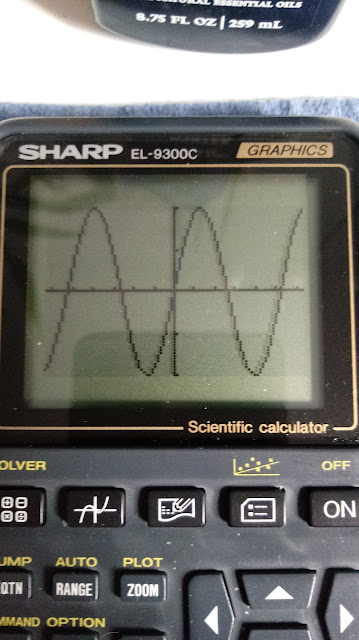Retro Review: Sharp EL-9300C
Quick Facts
Model: EL-9300C
Company: Sharp
Years: 1995 - 2000s
Type: Graphing with Programming
Memory: 23,064 bytes (programming, statistics, graph database, solver equations)
Battery: 4 AAA batteries, with 1 CR 2032 backup
Logic: Algebraic, textbook
Comes with hard case. The calculator I purchased came had in it's original box and manual.
The EL-9300C is part of the Sharp EL-9200/9300 family. The earlier EL-9200/EL-9200C, released in 1992, had only 1,800 bytes. I'm not sure about the difference between the EL-9300 and the EL-9300C. The average cost of the EL-9300C is relatively inexpensive, around $15 to $25 U.S. dollars.
Features
* Mathematics with Calculus
* Complex Numbers Mode
* Matrices
* Base Mode
* Graphing: Function, Polar, Parametric
* Equation Solver
* Programming - up to 99 titled programs
* Statistics with Linear Regression
* Statistic Graphs with regression of six different regression fits
Mathematics with Calculus
The EL-9300C (and its graphing family) has a rich set of scientific functions including numerical calculus. The calculus functions include numeric derivative and numeric integral.
The numeric derivative works on functions in terms of X using the standard definition of the derivative:
f'(x) = (f(x+h) -f(x)) / h, where h can be designated as an optional argument.
The numeric integral uses to commands: ∫ and dx. The dx must be attached to the end unless an error occurs. The integral uses calculates the Simpson's Rule The number of subdivisions can be entered. It is an early graphing calculator, so expect the calculator to take a few seconds to calculate integrals.
Unfortunately, simplification of square roots and multiples of π are not included. The EL-9300 still has fractions and fraction simplification.
Complex Numbers Mode
For the time, the EL-9300 offers one most expansive set of pre-programmed calculations for complex numbers, which included logarithmic, power, exponential, trigonometric, and hyperbolic functions. In trade, there the mantissa is 8 digits instead of the normal 10, and the complex mode is still separate.
Matrices
Matrices are available, but they are in a separate mode. Matrices are edited, created, and deleted through the MENU key, while called up by using the "mat" suffix through the MATH-E-1 keystrokes.
Basic row operations, inverse, transpose, and determinant.
Base Mode
Base mode that allows logic operations for decimal, binary, hexadecimals, and octal integers are offered.
Regardless of display mode, all matrices are show by the matrix's columns.
Graphing: Function, Polar, Parametric
The EL-9300C has three graphing modes, accessed through the SET UP menu. If the calculator is in text mode, the function screen only displayed one equation at a time. The graphing speed is fairly decent.
Equation Solver
The solver is advanced, allowing for multi-character variables. There are three methods: Equation (where exact methods are used when available), Newton (using Newton's Method), and Graphic method.
Newton's Method: x_n+1 = x_n - f(x_n) ÷ f'(x_n)
Each equation can be saved and loaded into memory.
Note, the equation solver is not available on the EL-9200.
Programming
The programming model is a basic version of basic. Like the Equation Solver, multi-character variables are allowed. There is a basic set of graphing commands. The Input command included an automatic prompt. For example:
Input base returned base?
The automatic prompting will require getting used to.
Loops, both conditional and unconditional, are handled by the use of Goto and Label.
The EL-9300 can store up to 99 named programs.
The mode (Real, Matrix, N-Base, Complex) must be determined prior to creating a program. Unfortunately, I have no way to change the SET UP in the program, such as fix settings, angle mode, and coordinate/graphing mode, we have to keep this mind.
Statistics
The statistics mode uses an index card interface. There are four entry modes:
* one variable
* one variable with weights
* two variable
* two variable with weights
There is a one set of data and it must be cleared through the Delete Data (or Delete All) through the OPTION menu. Statistical data can be calculated and graphed. The EL-9300C offers up to six regression models (see below), but unfortunately, they are only available in graphing mode:
1. y = a + b ∙ x (linear)
2. y = a ∙ e^(b ∙ x) (exponential)
3. y = a + b ∙ ln x (logarithmic)
4. y = a + b ∙ log x (common logarithmic)
5. y = a ∙ x^b (power)
6. y = a + b ∙ x^-1 (inverse)
Common logarithmic is very unique, probably only offered on the EL-9200, EL-9300, and EL-9600 series.
In calculation mode, we only have linear regression.
One really cool feature of the Statistics mode, which will most likely not be able to found anywhere else is the ability to mask data. A masked data point turns that data point "off", temporarily excluding the data point from calculation.
Verdict
I like the perks of the EL-9300: the ability to mask data points in statistics, extensive set of complex number commands, the ability to save equations and use multi-character variable names (especially when most graphing calculators allowed only one-character variables, mainly A-Z and θ).
However, be prepared to use separate modes for matrices, complex numbers, and general calculations (real mode). The lack of set up commands in program will provide a challenge, and have to be set prior to running the programs.
For the price, I find that the calculator is a good buy.
Eddie
All original content copyright, © 2011-2021. Edward Shore. Unauthorized use and/or unauthorized distribution for commercial purposes without express and written permission from the author is strictly prohibited. This blog entry may be distributed for noncommercial purposes, provided that full credit is given to the author.





